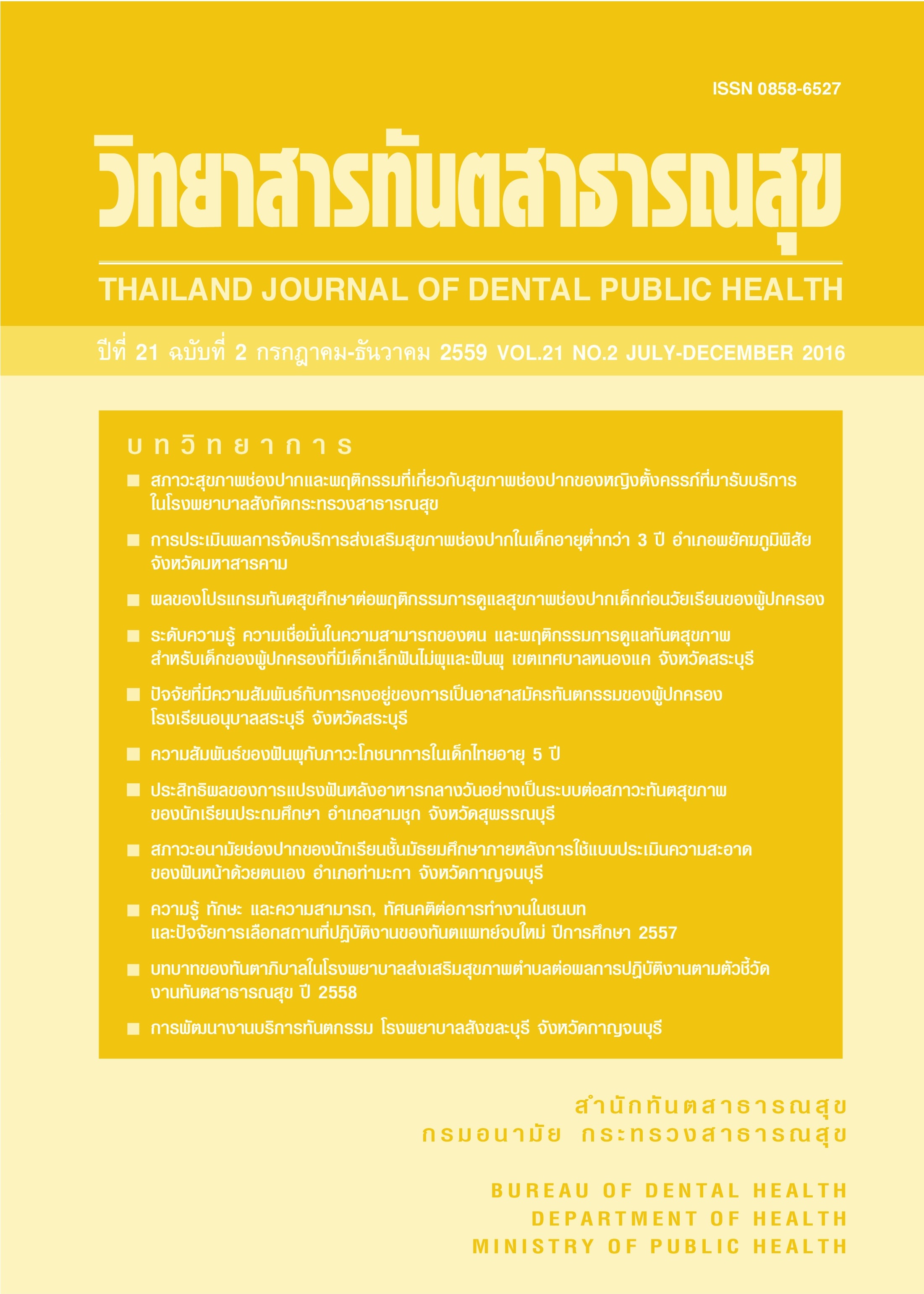The effectiveness of systematic tooth brushing program on oral health status among primary school students in Samchuk district Suphanburi province
Main Article Content
Abstract
The aim of this non-randomized longitudinal study cohort design was to evaluate the effectiveness of systematic tooth brushing program on oral health status among primary school students in Samchuk district, Suphanburi province. The comparison of oral health status and behavior of students among 4 schools of systematic tooth brushing program (S-group) and 4 schools of non-systematic tooth brushing program (NS-group) was done by using oral health status data from sealant program, Yimsodsai Dek Thai Fundee project. Oral health data of first grade students in 2009 were used as a baseline data compared to oral health status of the same student when they were at sixth grade in 2014. Analysis was done by using Chi-square analysis and independent t-test at 95% CI. Result showed that there were no statistically differences in DMFT between S-group and NS-groups at the baseline. By follow until grade sixth, the DMFT was significantly lower in the S-group than NS- group (DMFT=0.23 and 0.74 respectively, p=0.03). The incremental DMFT was significantly increased in both groups (p=0.043 in S-group, p=0.003 in NS-group). Mean gingival index, tooth brushing habit and sugar consumption behaviors were not difference. In conclusion, although there were DMFT increments in both groups, the incremental DMFT in S-group was significantly less increased than in NS-group.
Downloads
Article Details
References
2 Curnow MM, Pine CM, Burnside G, Nicholson JA, Chesters RK, Huntington E. A randomized controlled trial of the efficacy of supervised tooth brushing in high-caries-risk children. Caries Res 2002 Jul-Aug;36(4):294-300.
3 Ganss C, Schlueter N, Preiss S, Klimek J. Tooth brushing habits in uninstructed adults frequency, technique, duration and force. Clin Oral Investig 2009 Jun;13(2):203-8.
4 Poyato-Ferrera M, Segura-Egea JJ, Bullón-Fernández P. Comparison of modified Bass technique with normal tooth brushing practices for efficacy in supra gingival plaque removal. Int J Dent Hyg2003;1:110-4.
5 สำนักทันตสาธารณสุข กรมอนามัย. การพัฒนาระบบการจัดการข้อมูลเพื่อการเฝ้าระวังสุขภาพช่องปากและปัจจัยเสี่ยงสำคัญของประชาชนไทยระดับจังหวัด พ.ศ.2557. กรุงเพทฯ: สำนักงานกิจการโรงพิมพ์องค์การสงเคราะห์ทหารผ่านศึก; 2557.
6 สำนักทันตสาธารณสุข กรมอนามัย. รายงานผลการสำรวจสภาวะสุขภาพช่องปากระดับประเทศ ครั้งที่ 7ประเทศไทย พ.ศ. 2555. กรุงเทพฯ: สำนักงานกิจการโรงพิมพ์องค์การสงเคราะห์ทหารผ่านศึก; 2556.
7 Chounchaisithi N, Santiwong B, Sutthavong S, Asvanit P. Use of a disclosed plaque visualization technique improved the self-performed, tooth brushing ability of primary schoolchildren. J Med Assoc Thai 2014 Feb;97 Suppl 2:s88-95.
8 Gopinath VK, Rahman B, Awad MA. Assessment of gingival health among school children in Sharjah, United Arab Emirates. Eur J Dent. 2015 Jan-Mar;(9):36-40.
9 Levin KA, Currie C. Adolescent tooth brushing and the home environment ; socio demographic factors, family relationships and mealtime routines and disorganisation. Community Dent Oral Epidemiol 2010 Feb;38(1):10-8.
10 Punitha VC, Amudhan A, Sivaprakasam P, Rathanaprabu V. Role of dietary habits and diet in caries occurrence and severity among urban adolescent school children. Pharm Bioallied Sci 2015 Apr;7(suppl1):s296-300.
11 Beighton D, Adamson A, Rugg-Gunn A. Associations between dietary intake, dental caries experience and salivary bacterial levels in 12-year-old English schoolchildren. Arch Oral Biol 1996 Mar;41(3):271-80.
12 Bernabe E, Vehkalahti MM, Sheiham A, Aromaa A, Suominen AL. Sugar-sweetened beverages and dental caries in adults:A 4-year prospective study. J Dent 2014 Aug;42(8):952-8.
13 Armfield JM, Spencer AJ, Roberts-Thomson KF, Plastow K. Water fluoridation and the association of sugar-sweetened beverage consumption and dentalcaries in Australian children. Am J Public Health 2013 Mar;103(3):494-500.


